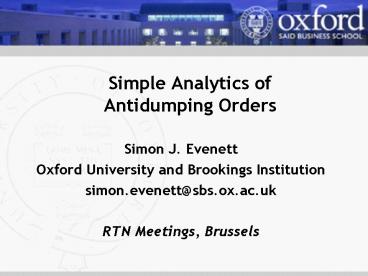Simple Analytics of Antidumping Orders
1 / 21
Title:
Simple Analytics of Antidumping Orders
Description:
Spread of Antidumping laws around the world (Stephenson 2000, Prusa 2004) ... Simple Bertrand duopoly. One period. Firms (h, f) supply Home market only. ... –
Number of Views:40
Avg rating:3.0/5.0
Title: Simple Analytics of Antidumping Orders
1
Simple Analytics of Antidumping Orders
- Simon J. Evenett
- Oxford University and Brookings Institution
- simon.evenett_at_sbs.ox.ac.uk
- RTN Meetings, Brussels
2
Contents of this presentation
- Motivation.
- Point of departure from the existing literature.
- A simple model.
- Concluding remarks.
3
Motivation
- Spread of Antidumping laws around the world
(Stephenson 2000, Prusa 2004). - Many new laws copy existing laws.
- Considerable discretion in the application of
these lawsespecially w.r.t. the calculation of
dumping margins (Blonigen 2003). - Controversy over the Byrd Amendment
- WTO DSU case.
4
Point of departure from existing literature
- Focus here is on AD ordersnot AD investigations
or the threat of AD actions. - Explicitly model three important features of US
AD practice - Sliding scale of tariffs.
- Discretion over choice of foreign market value
(FMV)and related uncertainty. - Byrd Amendment.
- What incentives are created by these features?
- Collie and Vandenbussche (2004).
5
Initial assumptions of the model
- Simple Bertrand duopoly.
- One period.
- Firms (h, f) supply Home market only.
- Constant marginal costs, cf and ch.
- Linear demand schedules
6
Institutional assumptions on AD orders
- Tariff schedule
- Anti-importer bias in setting of FMV
- Byrd Amendment.
7
Models presented in paper.
- Benchmark case no AD order (section 2).
- Model with AD order only (section 3).
- Model with AD order and Byrd Amendment (section
4). - Model with AD order and anti-importer bias
(section 5). - Model with AD order, anti-importer bias, and Byrd
Amendment (section 6).
8
Model with AD order only (section 3).
9
Model with AD order only (section 3).
Pf
New RF
FMV
Old RF
Ph
10
Dumping persists in equilibrium.
Home RF
Pf
New RF
FMV
Old RF
Ph
11
Dumping eliminated in equilibrium.
Pf
New RF
Home RF
FMV
Old RF
Ph
12
Model with AD order and Byrd Amendment (section 4)
13
Model with AD order and Byrd Amendment (section
4).
Pf
New RF
FMV
Old RF
Ph
14
Byrd Amendment has no effect when dumping was
eliminated by AD order.
Pf
For RF
FMV
Home RF
Ph
15
Byrd Amendment raises prices and imports when
dumping persists
Pf
For RF
Home RF
FMV
Ph
16
Model with AD order and anti-importer bias
(section 5).
17
Model with AD order and anti-importer bias
(section 5).
Pf
New RF
Old RF
? FMV
FMV
Free RF
Ph
18
Model with AD order and anti-importer bias
(section 5).
Pf
New RF
Old RF
? FMV
FMV
Free RF
Ph
19
All features together (section 6).
20
All features together (section 6).
Pf
New Home
? FMV
EFMV
FMV
Ph
Free Home
21
All features together (section 6).
Pf
New Home
New For
? FMV
EFMV
Free For
FMV
Ph
Free Home
22
Concluding remarks
- Sliding scale nature of US AD orders creates
incentives to eliminate dumping, which are
strengthened by anti-importer bias in calculation
of FMV. - Byrd Amendment creates a price floor in home
firms reaction function. - When dumping persists, Byrd Amendment raises
prices of both firms goods and increases
imports. - Issues of generality.
- Relationship to WTO Appellate Body decision.































